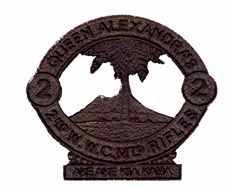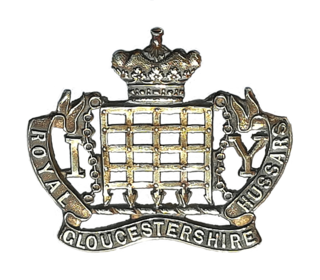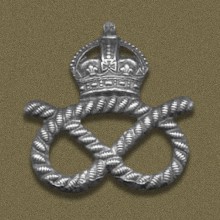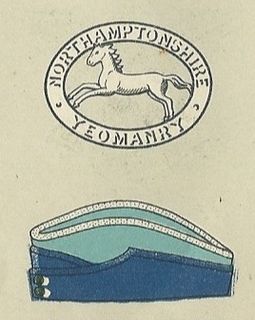| 1st Mounted Rifles (Canterbury Yeomanry Cavalry) | |
|---|---|
| Active | 1911–1944 |
| Country | New Zealand |
| Allegiance | New Zealand Crown |
| Branch | New Zealand Army |
| Role | Mounted Rifles |
| Size | One Regiment |
| Part of | New Zealand Mounted Rifles Brigade |
| Engagements | World War I |

| 1st Mounted Rifles (Canterbury Yeomanry Cavalry) | |
|---|---|
| Active | 1911–1944 |
| Country | New Zealand |
| Allegiance | New Zealand Crown |
| Branch | New Zealand Army |
| Role | Mounted Rifles |
| Size | One Regiment |
| Part of | New Zealand Mounted Rifles Brigade |
| Engagements | World War I |

The Canterbury Yeomanry Cavalry was established as a volunteer corps at Christchurch in 1864. [1] It was the oldest of twelve light cavalry units raised in New Zealand during the second half of the nineteenth century, using the British Yeomanry regiments as a model. [2]
While numbering less than 100 men, scattered in small detachments across Canterbury Province, the unit earned a reputation for well drilled smartness and provided honour guards and ceremonial escorts as required. It was brought together for a training camp of eight days each year. A scarlet and blue uniform was worn with black facings and a red plumed helmet. [3]
With the introduction of a conscription-based territorial system in 1911-12, the Canterbury Yeomanry Cavalry became "A" Squadron of the 1st Mounted Rifles (Canterbury Yeomanry Cavalry). [4]
The 1st Mounted Rifles (Canterbury Yeomanry Cavalry) was formed on March 17, 1911. They were mobilised during World War I as a squadron of the Canterbury Mounted Rifles Regiment. They served in the Middle Eastern theatre of World War I and first saw action during the Battle of Gallipoli.
As a part of the larger New Zealand Mounted Rifles Brigade (of the ANZAC Mounted Division) they went on to serve in the Sinai and Palestine Campaign. [5] [6]
In 1921 they were amalgamated with the 8th (South Canterbury) Mounted Rifles and redesignated the Canterbury Yeomanry Cavalry. By 1942, the regiment, as 1st Light Armoured Fighting Vehicles Regiment (Canterbury Yeomanry Cavalry), was part of the 5th Division's divisional troops, located at Ashburton. [7]
They were absorbed into the 3rd Armoured Regiment RNZAC on 29 March 1944. [5]

The Sherwood Rangers Yeomanry (SRY) is one of the six squadrons of the Royal Yeomanry (RY), a light cavalry regiment of the Army Reserve. Designated as 'A' Squadron, the Sherwood Rangers Yeomanry's current role is to support the Light Cavalry Regiments on operations by providing skilled reconnaissance soldiers.

Queen Alexandra's Mounted Rifles (QAMR) is an armoured regiment of the New Zealand Army and forms part of the Royal New Zealand Armoured Corps. The regiment was formed in 1864 and is currently an armoured cavalry unit equipped with NZLAV.

The Waikato Mounted Rifles (WMR) is the New Zealand Army's only Territorial Force squadron of the Royal New Zealand Armoured Corps (RNZAC). The Squadron's origins can be traced back to 1869 when the first mounted unit was raised in the Waikato. Today the Squadron is part of Queen Alexandra's Mounted Rifles (QAMR) where it forms the regiment's reserve squadron. WMR's role is mounted reconnaissance and surveillance.

The City of London Yeomanry was a yeomanry regiment of the British Territorial Army, formed in 1901. It amalgamated with the Inns of Court Regiment to form the Inns of Court & City Yeomanry in 1961. The lineage is maintained by 68 Signal Squadron, part of 71 (Yeomanry) Signal Regiment.

The Royal Gloucestershire Hussars was a volunteer yeomanry regiment which, in the 20th century, became part of the British Army Reserve. It traced its origins to the First or Cheltenham Troop of Gloucestershire Gentleman and Yeomanry raised in 1795, although a break in the lineage means that its formation is dated to the Marshfield and Dodington Troop raised in 1830. Six further troops – officered by nobility and gentry, and recruited largely from among landholders and tenant farmers – were subsequently raised in Gloucestershire, and in 1834 they came together to form the Gloucestershire Yeomanry Cavalry. In 1847, the regiment adopted a hussar uniform and the name Royal Gloucestershire Hussars. Originally intended to counter insurrection and a French invasion that never materialised, the yeomanry's first deployments were ceremonial and as mounted police during times of civil unrest. Three Gloucestershire troops were deployed to Bristol on two separate occasions in the 1830s in support of the civil authorities.

The Staffordshire Yeomanry was a unit of the British Army. Raised in 1794 following Prime Minister William Pitt's order to raise volunteer bodies of men to defend Great Britain from foreign invasion, the Staffordshire Yeomanry began as a volunteer cavalry regiment.

The Derbyshire Yeomanry was a yeomanry regiment of the British Army, first raised in 1794, which served as a cavalry regiment and dismounted infantry regiment in the First World War and provided two reconnaissance regiments in the Second World War, before being amalgamated with the Leicestershire Yeomanry to form the Leicestershire and Derbyshire Yeomanry in 1957.
The Warwickshire Yeomanry was a yeomanry regiment of the British Army, first raised in 1794, which served as cavalry and machine gunners in the First World War and as a cavalry and an armoured regiment in the Second World War, before being amalgamated into the Queen's Own Warwickshire and Worcestershire Yeomanry in 1956. The lineage is maintained by B Squadron, part of The Royal Yeomanry.

The Royal Wiltshire Yeomanry (RWY) was a Yeomanry regiment of the Kingdom of Great Britain and the United Kingdom established in 1794. It was disbanded as an independent Territorial Army unit in 1967, a time when the strength of the Territorial Army was greatly reduced. The regiment lives on in B and Y Squadrons of the Royal Wessex Yeomanry.

The Northumberland Hussars is a British Territorial Army Squadron equipped with FV107 Scimitar and FV103 Spartan armoured reconnaissance vehicles. The squadron is part of The Queen's Own Yeomanry (QOY), a Formation Reconnaissance Regiment. The 'Hussars' are based in Newcastle upon Tyne.
The Royal East Kent Yeomanry was a British Army regiment formed in 1794. It saw action in the Second Boer War and the First World War.

The Queen's Own West Kent Yeomanry was a British Army regiment formed in 1794. It served in the Second Boer War and the First World War. It amalgamated with the Royal East Kent Yeomanry to form the Kent Yeomanry in 1920.

The Northamptonshire Yeomanry was a Yeomanry regiment of the British Army, formed in 1794 as volunteer cavalry. It served in the Second Boer War, the First World War and the Second World War before being reduced to squadron level in 1956. It ceased to have a separate existence in 1971.

The Middlesex Yeomanry was a volunteer cavalry regiment of the British Army originally raised in 1797. It saw mounted and dismounted action in the Second Boer War and in World War I at Gallipoli, Salonika and in Palestine, where one of its officers won a Victoria Cross at the Battle of Buqqar Ridge and the regiment rode into Damascus with 'Lawrence of Arabia'. Between the world wars the regiment was converted to the signals role and it provided communications for armoured formations in World War II, including service in minor operations in Iraq, Palestine, Syria and Iran, as well as the Western Desert, Italian and North-West European campaigns. It continued in the postwar Territorial Army and its lineage is maintained today by 31 Signal Squadron, Royal Corps of Signals, which forms part of the Army Reserve.

The 3rd (Auckland) Mounted Rifles was formed on March 17, 1911. They were mobilised during the First World War as a squadron of the Auckland Mounted Rifles Regiment. They served in the Middle Eastern theatre of World War I and first saw action during the Battle of Gallipoli. As a part of the larger New Zealand Mounted Rifles Brigade they went on to serve in the Sinai and Palestine Campaign.

The 6th (Manawatu) Mounted Rifles was formed on March 17, 1911. They were mobilised during World War I as a squadron of the Wellington Mounted Rifles Regiment. They served in the Middle Eastern theatre of World War I and first saw action during the Battle of Gallipoli. As a part of the larger New Zealand Mounted Rifles Brigade, they went on to serve in the Sinai and Palestine Campaign.

The 8th Mounted Rifles was formed on March 17, 1911. They were mobilised during World War I as a squadron of the Canterbury Mounted Rifles Regiment. They served in the Middle Eastern theatre of World War I and first saw action during the Battle of Gallipoli. As a part of the larger New Zealand Mounted Rifles Brigade they went on to serve in the Sinai and Palestine Campaign.

The 9th Mounted Rifles was formed on March 17, 1911. They were mobilised during World War I as a squadron of the Wellington Mounted Rifles Regiment. They served in the Middle Eastern theatre of World War I and first saw action during the Battle of Gallipoli. As a part of the larger New Zealand Mounted Rifles Brigade they went on to serve in the Sinai and Palestine Campaign.

The 10th (Nelson) Mounted Rifles, previously known as the 1st Regiment, Nelson Mounted Rifles is a military unit based in Nelson, New Zealand. They served in the Middle Eastern theatre of World War I and first saw action during the Battle of Gallipoli. As a part of the larger New Zealand Mounted Rifles Brigade they went on to serve in the Sinai and Palestine Campaign.

The 11th Mounted Rifles was formed on 17 March 1911. They were mobilised during World War I as a squadron of the Auckland Mounted Rifles Regiment. They served in the Middle Eastern theatre of World War I and first saw action during the Battle of Gallipoli. As a part of the larger New Zealand Mounted Rifles Brigade they went on to serve in the Sinai and Palestine Campaign.